One of the most diverse marine ecosystems has been in trouble for years. Warmer ocean temperatures, ocean acidification (the ongoing decrease of the oceans’ pH-level directly related to the increase of carbon dioxide emissions – “the evil twin of global warming”), overfishing which can use techniques such as dynamite explosions and cyanide poisoning, and runoff from agricultural pollution all play a role in the decline of shallow tropical coral reefs which was first noticed in the 1950s.
But more recently the articles warning about the precarious condition of coral reefs, particularly the Great Barrier Reef near Australia, sound more urgent and appear more frequently. Just today, a newsletter from The Guardian warned of “Coral Grief”; record ocean temperatures are turning the Great Barrier Reef into a graveyard.
I realized that I knew very little about corals and reefs, so I did some research. Yes, they’re not plants, although they can look like seaweeds and exotic flowers, I was aware of that. But animals? Really?
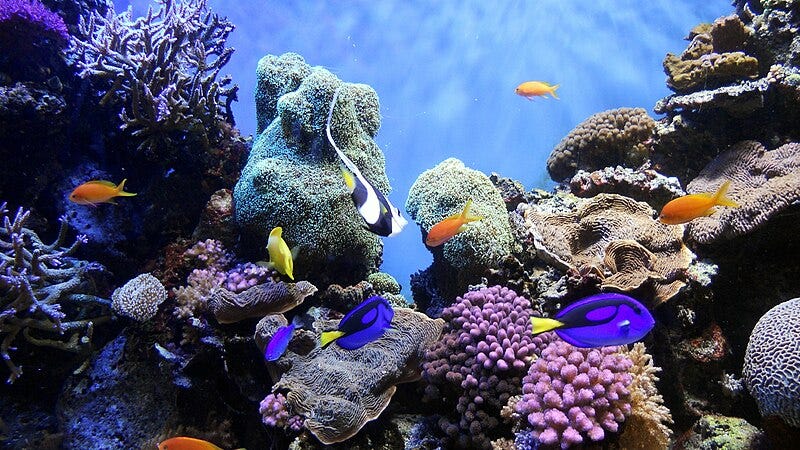
Really. Corals are marine invertebrates which means they don’t have a spine or backbone, the core part of the skeletons of vertebrate animals. Corals belong to the earliest animals on earth, they have been around for close to 600 million years. Jellyfish, sea anemones, and sponges are other examples of invertebrates.
But there’s something special about corals: they are colonial organisms which means that they consist of hundreds of thousands of discrete but physically connected individuals that work together as a unit, a super organism. Just like a beehive! Working together for the wellbeing of the community, or colony – I find this fascinating and intriguing. Maybe that’s how human beings should function? Would this be at all possible when the individuals are self-conscious?

Not as long as the human ego is in charge, as long as “I” am the center of the universe, as long as my personal wellbeing is the most important. However, this is even mentioned in the Declaration of Independence: Life, Liberty, and the pursuit of Happiness are unalienable rights. For humans. But I’m quite certain that all sentient beings strive to feel content and happy. This brings up the question: when MY happiness depends on another being’s suffering and death, do I still have the right to pursue it? If it makes me happy to hunt rhinoceroses, do I have the right to kill the last existing white one?
Well, you might say, that’s the way of nature: lions kill antelopes, cats kill birds and mice, snakes kill rabbits. They don’t care either if a species goes extinct. But this leaves out one important fact: human beings have the ability to say NO. I don’t think this gets enough attention. I can say No to something that gives me pleasure, to an impulse, a desire, a craving because I can decide that it’s ethically wrong, or that it harms others, or me. Granted, often that’s not easy, but it’s possible.
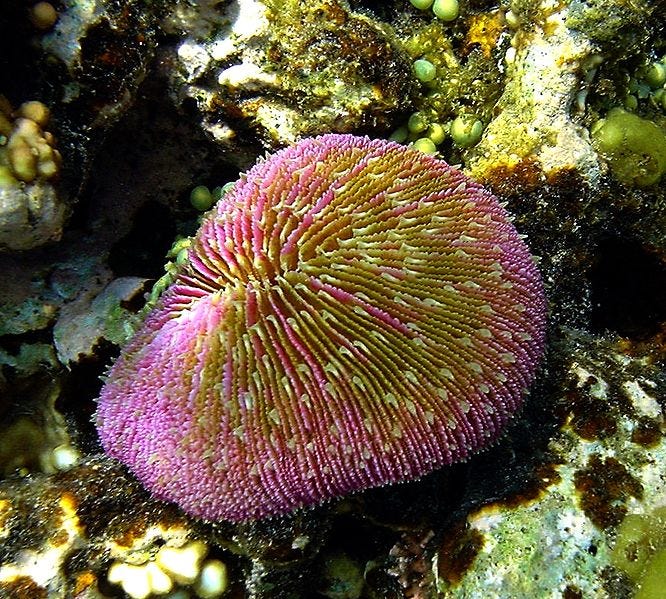
But let’s get back to corals and the colonies they build: each colony consists of many genetically identical organisms called polyps. They’re all clones of one another, and they can reproduce both sexually (by creating eggs and sperm that fuse to create larvae) and asexually, where a broken-off piece can continue to grow by cloning itself. Once they settle down they secrete an exo- skeleton made of calcium carbonate (CaCO3). This happens at the lower portion of the polyp and creates something like a cup or calyx, and the polyp sits in the middle of it. The coral grows when the polyp builds a new cup on top of the lower one.

Reef-building, shallow-water corals that live in warm water form a symbiotic relationship with microscopic algae called zooxanthellae which provide them with nutrients and energy. These little plant-like creatures are the reason for the green, brown, and reddish colors of the corals, and because they provide about 90% of the nutrients the polyps need, coral reefs can grow much faster in clear water which admits a lot of sunlight, at depths less than 200 feet.

The Great Barrier Reef, which is located off the coast of Queensland, Australia, is one of these fast-growing reefs. It spans some 1,400 miles, covers about 133,000 square miles, and is the world’s biggest single structure made by living organisms, by billions of tiny coral polyps. It started growing 20,000 years ago! And it is one of the most diverse and valuable ecosystems on Earth, providing a home to a huge number of marine animals such as diverse fishes, mollusks, sea turtles, giant clams, crabs, and a host of other creatures. That’s why it’s such a tragedy what is happening there: countless polyps, the tiny animals that keep the reef alive and growing, are dying.
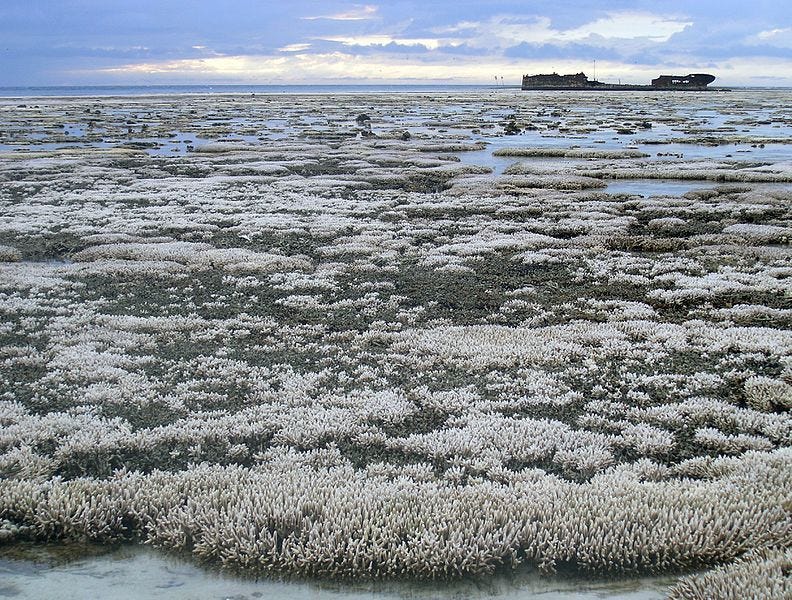
It’s called “bleaching” because all the color has left the corals, but there’s no bleach involved. Climate change has caused a steady warming of ocean waters, making them more acidic and lowering the pH level. The algae living in a symbiotic relationship with the polyps can’t handle the acidic water and produce a substance which is poisonous for the polyps, so they expel the algae – hence the loss of color.
The polyps don’t die immediately, but they depend on the algae for nutrients, and they slowly starve. And if that wasn’t enough, these stressed polyps can’t defend themselves any more against bacteria and viruses. For example, “dinoflagellate-infecting RNA viruses” infect the algae living in the corals, which again results in starving polyps.
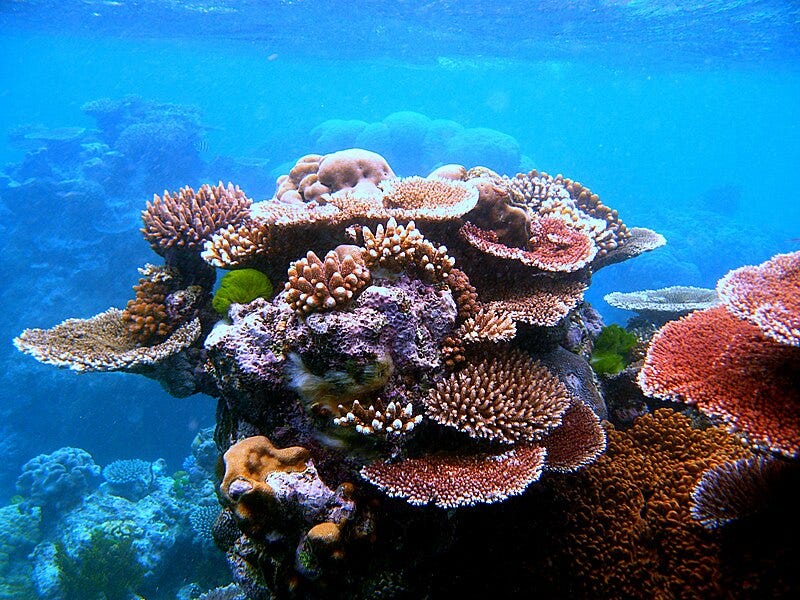
Luckily, there are concentrated efforts to save coral reefs: governments, NGOs, and many marine scientists strive to stem the catastrophic effects of warming ocean waters (which won’t let up soon because the El Niño weather pattern can cause increased sea surface temperatures, decreased sea levels, and increased salinity from altered rainfall). Several areas, including the Great Barrier Reef, are Marine Sanctuaries and there’s even a Marine National Monument. Plus, the Great Barrier Reef is a UNESCO World Heritage Site, which grants some management and long-term planning. These sites are protected from overfishing, increased shipping activity, expansive coastal development, and poisonous agriculture runoff.
Underwater forests of plastic trees are nurseries which cultivate juvenile corals which are then planted on a reef. These coral farms have been successful in lowering polyp and juvenile mortality rates and belong to the most effective methods for coral restoration. However, they can’t prevent climate stressors: warming sea temperatures and more violent hurricanes can disrupt and kill the corals in a nursery. Unless we get global warming under control, coral reefs and the countless marine species they provide a home for will be in grave danger.





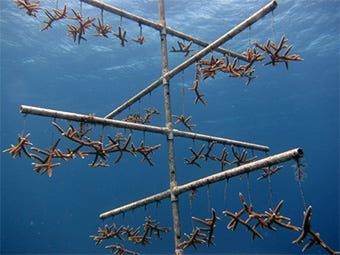
Thanks for another solid article. I hold out a hope that they will return after we humans are dead and gone and they probably will.
so much of our beautiful biosphere is being threatened and destroyed / a tragedy because it's beautiful and because it's our biosphere / and so much lamentation going on about it too / thanks for pointing out some positive solutions